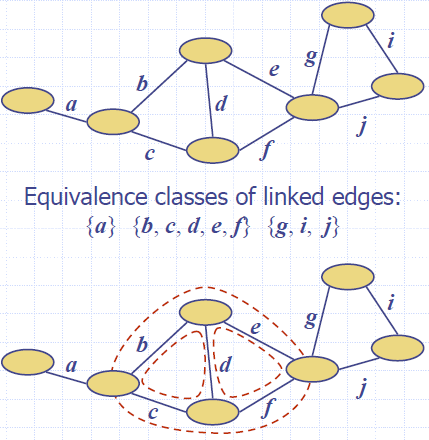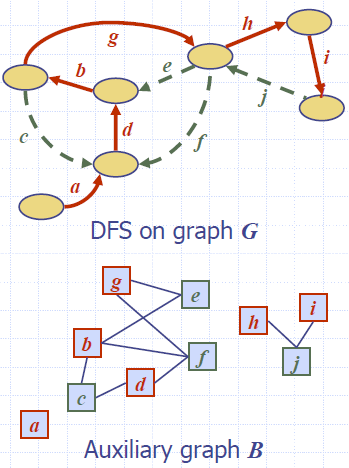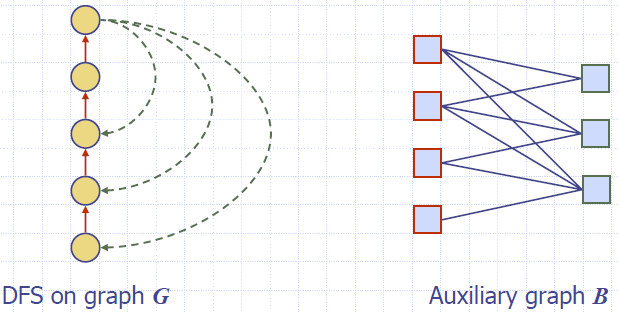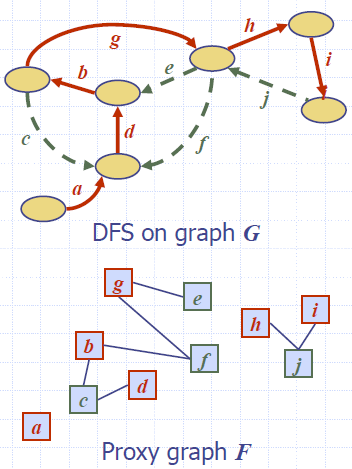Biconnectivity
Separation Edges and Vertices
- Definitions
- Let G be a connected graph
- A separation edge of G is an edge whose removal disconnects G
- A separation vertex of G is a vertex whose removal disconnects G
- Applications: Separation edges and vertices represent single points of failure in a network and are critical to the operation of the network
- Example
- DFW, LGA and LAX are separation vertices
- (DFW,LAX) is a separation edge

Biconnected Graph
- Equivalent definitions of a biconnected graph G
- Graph G has no separation edges and no separation vertices
- For any two vertices u and v of G, there are two disjoint simple paths between u and v (i.e., two simple paths between u and v that share no other vertices or edges)
- For any two vertices u and v of G, there is a simple cycle containing u and v
- Example

Biconnected Components
- Biconnected component of a graph G
- A maximal biconnected subgraph of G, or
- A subgraph consisting of a separation edge of G and its end vertices
- Interaction of biconnected components
- An edge belongs to exactly one biconnected component
- A nonseparation vertex belongs to exactly one biconnected component
- A separation vertex belongs to two or more biconnected components
- Example of a graph with four biconnected components

Equivalence Classes
- Given a set S, a relation R on S is a set of ordered pairs of elements of S, i.e., R is a subset of S×S
- An equivalence relation R on S satisfies the following properties
- Reflexive: (x,x) ∈ R
- Symmetric: (x,y) ∈ R ⇒ (y,x) ∈ R
- Transitive: (x,y) ∈ R ∧ (y,z) ∈ R ⇒ (x,z) ∈ R
- An equivalence relation R on S induces a partition of the elements of S into equivalence classes
- Example (connectivity relation among the vertices of a graph):
- Let V be the set of vertices of a graph G
- Define the relation
C = {(v,w) ∈ V×V such that G has a path from v to w}
- Relation C is an equivalence relation
- The equivalence classes of relation C are the vertices in each connected component of graph G
Link Relation
- Edges e and f of connected graph G are linked if
- e = f, or
- G has a simple cycle containing e and f
- Theorem:
- The link relation on the edges of a graph is an equivalence relation
- Proof Sketch:
- The reflexive and symmetric properties follow from the definition
- For the transitive property, consider two simple cycles sharing an edge

Link Components
- The link components of a connected graph G are the equivalence classes of edges with respect to the link relation
- A biconnected component of G is the subgraph of G induced by an equivalence class of linked edges
- A separation edge is a single-element equivalence class of linked edges
- A separation vertex has incident edges in at least two distinct equivalence classes of linked edge

Auxiliary Graph
- Auxiliary graph B for a connected graph G
- Associated with a DFS traversal of G
- The vertices of B are the edges of G
- For each back edge e of G, B has edges (e,f1), (e,f2) , …, (e,fk), where f1, f2, …, fk are the discovery edges of G that form a simple cycle with e
- Its connected components correspond to the the link components of G

- In the worst case, the number of edges of the auxiliary graph is proportional to nm

Proxy Graph
- Proxy graph F for a connected graph G
- Spanning forest of the auxiliary graph B
- Has m vertices and O(m) edges
- Can be constructed in O(n + m) time
- Its connected components (trees) correspond to the the link components of G
- Given a graph G with n vertices and m edges, we can compute the following in O(n + m) time
- The biconnected components of G
- The separation vertices of G
- The separation edges of G

Algorithm proxyGraph(G)
Input connected graph G
Output proxy graph F for G
F ← empty graph
DFS(G, s) { s is any vertex of G}
for all discovery edges e of G
F.insertVertex(e)
setLabel(e, UNLINKED)
for all vertices v of G in DFS visit order
for all back edges e = (u,v)
F.insertVertex(e)
repeat
f ← discovery edge with dest. u
F.insertEdge(e,f,∅)
if f getLabel(f) = UNLINKED
setLabel(f, LINKED)
u ← origin of edge f
else
u ← v { ends the loop }
until u = v
return F